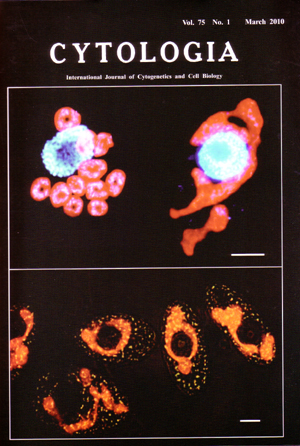| ON THE COVER |  |
|---|---|
| Vol. 75 No.1 March 2010 | |
| Technical note | |
|
|
|
| Formation of "giant chloroplast"
during the cell cycle of Euglena gracilis Z in synchronized culture Cells of Euglena gracilis Z were synchronized by applying a 14-h light : 10-h dark regimen under photoautotrophic conditions. The cell suspension was mixed with l0% glutaraldehyde to give a final concentration of 0.1% followed by immediate centrifugation for 7 min at 4°C. The sedimented cells were washed with culture medium to remove glutaraldehyde. One drop of cell suspension was placed on a glass slide and was mixed with 1drop of a solution of 5 µg DAPI (4',6-diamidino-2-phenylindole)per ml of NS buffer (20mM Tris-HCI (pH 7.6), 0.25M-sucrose, 1 mM EDTA, 1 mM MgC12, 0.1mM ZnS04, 0.1mM CaC12, 0.8mM phenylmethylsulphonyl-fluoride, 0.05% 2- mercaptoethano1). After 1h, observations were made with an Olympus fluorescence microscope (RFL-K), and photographs were taken. In the cell cycle of Euglena gracilis Z in synchronized cultures, chloroplasts temporarily conjoin to form a single giant structure at the 14th hour after the onset of the light period, called "giant chloroplast" (upper in right and bottom), which surrounds the nucleus making connections or close contacts at several sites. The upper left shows the 10th hour after the onset of the light period. The cell contained 11 chloroplasts and chloroplasts were round or oval in shapes and dispersed in the cytoplasm. Chloroplast nucleoids in the "giant chloroplast", observed under a fluorescence microscope after staining with DAPI, the DNA fluorochrome, become stringy and some tips of the string appeared to come into close proximity to the site of connection with the nucleus (upper in right). Bar (upper, bottom: 5µm). A chromosome is always present close to the site of the nuclear envelope connected to the chloroplast. Such a close association between the nucleus and conjoined chloroplasts occurs twice in the cell cycle; first, at an early phase of cell growth and secondly, at a stage immediately prior to the chloroplast division. (Tetsuaki Osafune, Kazuyuki Tanaka and Tomoko Ehara, Department of Life Science, Nippon Sport Science University, Yokohama 227-0033, Japan; Department of Microbiology, Tokyo Medical University, Tokyo 160-8402, Japan) |
|